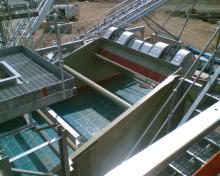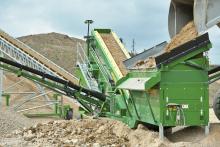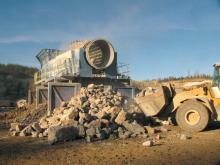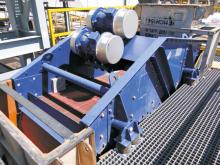Once a secondary design consideration, screening technology – now deemed the mainstay of any mill circuit – has become a crucial factor as quarries seek to ensure that their material processing operations run cost-effectively. Munesu Shoko reports.
Although commodity prices saw a slight recovery in 2017, investment in downstream sectors such as construction in sub-Saharan Africa remains cautious. Continued innovation in the industry is key, especially in an environment where business expansion is very tentative and costs still need to be tightly controlled. As these pressures build, quarry operators are re-examining their equipment, placing more focus on maximising efficiency and productivity to maintain or even improve their bottom lines.
Consequently, there is a greater focus on integrated processing solutions, especially screening technology, which is deemed the mainstay of a mill circuit. Reiterating the importance of screening technology, Corné Kleyn, product manager –
Graham Standers, sales manager – Vibrating Equipment at MBE Minerals SA, says milling circuits are designed to operate under specific conditions, not least of which is the size range of material being fed to the screen. “Efficient screening ensures an accurate size range of material feed to the milling circuit,” he says.
Dave Sibley, of ELB Screening Technology Solutions, says far from merely acting as a means of separating and sizing materials, the effective use of screening technologies can contribute to the overall efficiency of a plant and can significantly improve return on investment in terms of processing costs.
Martin Botha, marketing director at Osborn Engineered Solutions, says screens are more efficient when compared with cyclones in that less water will bypass to the oversize product and therefore less finess will be carried back to the mill. “The challenge, however, has always been finding a fines screening solution that can offer cut sizes in the 45 µm to 220 µm range, typically covered by hydrocyclones. For coarser primary mill product sizes, the obvious choice becomes a standard vibrating screen where aperture sizes from 300 µm are now available,” says Botha.
Botha adds that the finesr aperture sizes used on standard vibrating screens do, however, require specialist sizing methods. “There have been a number of screens installed in recent times where the capacity has been incorrectly catered for, resulting in an undersized circuit. Osborn has the necessary expertise to provide such sizing and has, in fact, supplied a number of these fines aperture screens in the past with no sizing issues.”
Sandro Scherf, CEO of
There are several criteria to consider when evaluating screening technology, from separation efficiency and equipment durability, to overall maintenance costs and aftermarket support.
According to Standers, correct selection of screening equipment in terms of the required area is very important in order to provide sufficient screening area for the required process, and factors such as increased future feed requirements, as well as changing feed conditions, should be carefully studied. “The conditions under which the screen operates, such as operating speed, machine acceleration and vertical acceleration, are essential considerations,” he says, adding that the cost of the equipment, not only in terms of capital cost, but the cost of operating and maintaining it during the expected lifecycle of the plant, should also be a primary consideration.
The same view is shared by Botha, who says, from a milling perspective, it is of utmost significance that the screen be properly sized so that there won’t be any slurry pouring onto the screen oversize belt. “Reduced circulating loads also allow for more fresh feed into the milling circuit. Lower circulating loads also mean less wear in the system,” he says.
Scherf says, firstly, there is need to determine feed material size, which informs the decision between a primary and a final screen. “The second consideration would be the feed rate and media options to determine the size of the screen. And lastly, screen efficiency, screen accuracy, parts availability, service intervals and service friendliness to have the lowest cost per tonne should form part of the selection process,” says Scherf.
Kleyn reiterates that selecting appropriate screening technology to use in an application is absolutely critical to ensure the screen operates reliably and efficiently. “Some of the factors to consider include material type, bulk-density, feed gradation, material top lump size, required cut size, clay content and feed-moisture,” says Kleyn, adding that, based on these variables, OEMs need to consider design decisions, including required stroke, material travel rate, bed depth, deck load, wear protection, angle of inclination, spray water addition and other parameters.
There are several typical screening applications, including classification, dewatering, heavy media recovery, scalping, trash removal and grading. Each screening application is suited to a certain type of screen, and it is important to choose the right screen for the job at hand.
Scherf says grizzly feeders and scalpers (TK, VG, VF) are suited to finess removal at the primary station, because they have a linear motion. “Scalping screens are suited for finess removal at the secondary station or taking out hand stone. A product can be removed at this stage and this creates capacity capabilities at the secondary crushing station. The scalping screen grizzly bars can also be replaced with tines for sticky material in recycling or sticky applications, because they also have a linear motion,” he says.
Dual slope and triple slope screens (DS, TS) are used for screening at the secondary stage or the final crushing stage. They can handle high production rates, and at the same time, can be very efficient. “They have a combination of circular and elliptical motion. Washing is available with these screens, with a wide variety of screening media,” adds Scherf.
Incline screens (CVB) are very popular in the construction industry due to their simple design, ease of maintenance and parts availability. They have a circular motion. Washing is also available with these screens, with a wide variety of screening media. “Horizontal screens (FS, ES) are used where there are installation needs to be done in tight spaces. Normal installation is also possible. These screens are very accurate due to their design and ellipse motion,” says Scherf.
Weir Minerals offers single- and double-deck configurations for linear motion screens, circular/elliptical motion screens and grizzly feeders. “Our linear motion screens, comprising multi-slope (banana), horizontal deck and inclined dewatering screens, are engineered to order to fit various screening duties including primary, secondary, tertiary, trash, drain and rinse, de-sliming, dewatering and protection screens,” says Kleyn.
“Our circular/elliptical motion screens include single-, double- and triple-deck horizontal and declined screens, suited for all applications in the aggregate market. We also offer grizzly feeders for primary screening and scalping duties,” adds Kleyn.
MBE Minerals SA is able to supply a comprehensive range of vibrating screens to suit most applications. These include RS/RFS type heavy-duty resonance drive scalpers; circular motion declined screens for wet or dry coarse separations; linear motion horizontal screens for finess separation, such as classifications and grading under wet or dry conditions; as well as wet applications such as feed preparation (desliming and dedusting); media recovery (drain and rinse); dewatering and trash removal.
“We also have multi-slope (banana) screens for specialised applications. We also offer an option of drives types, from vibrator motors on smaller equipment, to MBE Minerals’ proprietary side plate mounted drive on larger equipment,” says Standers.
Bearing in mind the diversity of screening needs, being able to deal with a single supplier that delivers end-to-end solutions, from product to aftermarket support, is of utmost significance.
Standers says MBE Minerals SA is not only a vibrating screen supplier with over 100 years of experience, but also a well-established supplier of processing equipment such as jigs, WHIMS electromagnetic separators, centrifuges and flotation equipment. “As such, we have a better understanding of what is required of screening equipment, and are able to offer a more balanced solution to screening requirements,” he says. “We are also able to draw on the experiences and knowledge of our worldwide partners in Germany, South America, Russia, India and China.”
Kleyn says Weir Minerals understands the need of its end-clients to deal with a “total solution partner”, hence it offers complete package deals inclusive of pumps, cyclones, vibrating feeders and screens, crushers, conveyors, hoses, spool-pieces, rubber-lining, valves and structural work. “Being involved throughout the complete plant process allows us to understand the interaction between upstream and downstream equipment and recommend adjustments to optimise the entire circuit,” says Kleyn.
Scherf says end-to-end solutions give the supplier the opportunity to assist the customer with the best production at the lowest cost. This is achieved by consolidating diverse equipment that matches and complements each other. “Parts supply and services can also be consolidated with proper planning from the supplier’s side to drive down downtime and service costs and increase plant availability,” he says.
Botha says being able to deal with a supplier that provides end-to-end screening solutions is critical. “A screen is the cheapest machine in a crushing circuit, but can cause the most problems when inefficient. Inefficient screens can cause unwanted recirculating loads that add load to the crushing or milling circuit, accumulating extra running costs and increased wear in the process,” concludes Botha.










